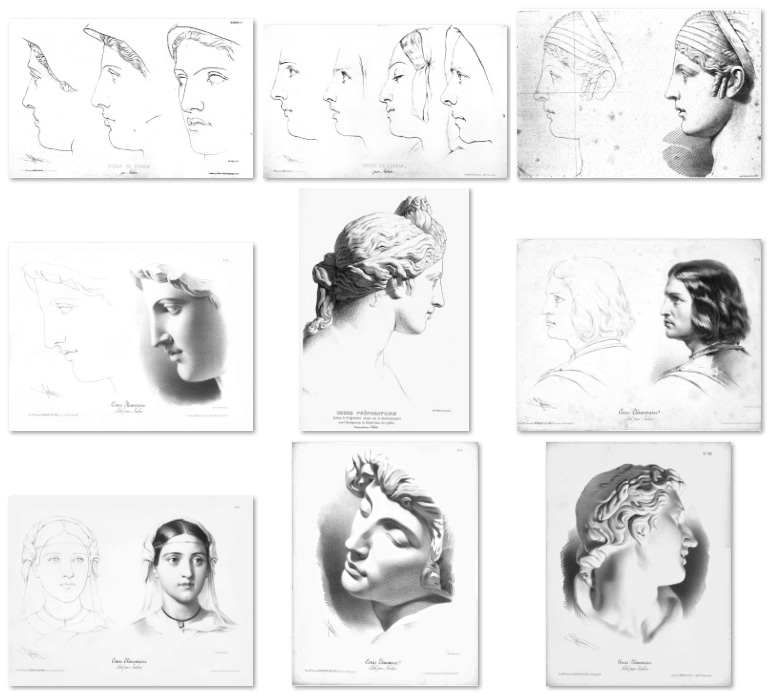The Academic method of figure drawing taught at many modern ateliers is based on methodologies formulated by the École des Beaux-Arts, the principal French academy in the 19th century. The core concept of “training the artist’s eye” stems from drawing courses such as those designed by Charles Bargue (c.1826/27–83), Bernard Romain Julien (1802–71), and Adolphe Yvon (1817–1893.)
Schools in this tradition strive to teach artists to represent nature faithfully. They don’t all use precisely the same methods, but they generally have two points in common: an emphasis on light and shadow, and a focus on converting three-dimensional figures into flat, two-dimensional shapes. Both of these areas of emphasis emulate nature as accurately as possible.
The method culminates in a rather sophisticated conceptualization of surface form, one that is not based on perception but rather on an understanding of the relationship between surface form and light source. The result can convey a beautiful 3D illusion."
For those interested in the aforementioned drawing manuals:
The Charles Bargue Drawing Course (c.1866-1871)
The Bargue-Gérôme Drawing Course is late nineteenth century drawing course. It contains a set of almost two hundred masterful lithographs of subjects for copying by drawing students before they attempt drawing from life or nature.
The Drawing Course consists of three sections. The first consists of plates drawn after casts, usually of antique examples. Different parts of the body are studied in order of difficulty, until full figures are presented. The second section pays homage to the western school of painting with lithographs after exemplary drawings by Renaissance and modern masters. The third part contains almost sixty académies or drawings after nude male models, all original inventions by Bargue, the lithographer. With great care, the student is introduced to continually more difficult problems in the close observing and recording of nature.
“First you did eyes, ears and noses, then feet, hands, arms and legs. Then heads: of children, adults and horses. Et voilà! You then arrived at the human figure. hat was the progression of lessons in ‘‘The Art of Drawing,’’ a 19th-century manual published in Paris from 1868 to 1871 by a little-known lithographer and painter, Charles Bargue (1826/27-1883), in collaboration with the overripe academic realist Jean-Léon Gérôme (1824-1904).” - Grace Glueck/NYTImes
You can purchase the a wonderful book on the Bargue Drawing Course by Gerald Ackerman here:
A few resources on the Bargue course are already available on Smartermarx:
Digital enhancements of Bargue Plates for use with the Language of Drawing/Painting or Visual Language programs:
EDITED BARGUE PLATES/SHAPE REPLICATION EXERCISES
Adolphe Yvon’s Méthode de Dessin (1867)
Adolphe Yvon (1817–1893) was a French painter known for his paintings of the Napoleonic Wars. Yvon studied under Paul Delaroche, rose to fame during the Second Empire, then finished his career as a teacher. For twenty years, between 1863 and 1883, Yvon taught at the École des Beaux-Arts. Among his many students were the Americans, J. Alden Weir and John Singer Sargent. During his tenure at the École, he produced his own drawing manual titled Méthode de Dessin. It was to be used as a basis for figure drawing instruction by other écoles in France, self-study students and as a supplement to his own teaching.
The book is 26 pages long, containing 24 lithographic plates describing the process of drawing the human figure and head. While copies of the original manuals are very scares (so I’ve been told), artist Darren Rousar has had the manual translated to English and has made it available for free download:
Adolphe Yvon’s Méthode de Dessin (1867) (English PDF)
Bernard Romain Julien’s Cours de Dessin (c.1860s?)
Cours Elémentaire (Elementary Drawing Course)
Bernard Romain Julien (1802 -1871) was a French printmaker, lithographer, painter and draughtsman. He was trained to draw in his home town between 1815 and 1818 before moving to Paris, where he studied painting from 1822 onwards under Antoine-Jean Gros at the École des Beaux-Arts. Like other drawing manuals of the time, Julien’s text featured prints to be copied. The average format of the prints was about
27.7 x 35.5 cm. I could not find too much more on Julien’s Cours Elémentaire but I have seen plates with numbers as high as 146 so it seemed to have been a fairly robust manual. Here are some edited samples that may also be used with Language of Drawing/Painting or Visual Language programs:
Bernard Romain Julien’s Cours de Dessin Edited Samples


